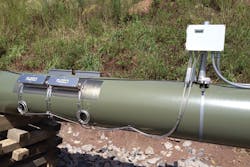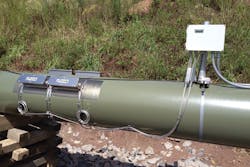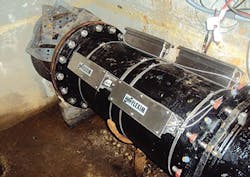Benefits of Ultrasonic Metering Technology
By Izzy Rivera and Jack Sine
For several years now there has been an increasing movement away from “intrusive” flow meters across numerous flow measurement applications including building maintenance, manufacturing, and, most recently, water and wastewater departments.
The reason? These types of meters - magnetic, vortex shedding, turbine, positive displacement, Coriolis, venturi, and others - come in direct contact with the flows they are measuring and many of them have moving parts or electrodes that can become fouled over time. Particulate buildup in the parts of the meters exposed to the flow translates into a need for maintenance, cleaning, and calibration.
These maintenance demands have led managers to consider alternative solutions.
Private Water Company Solves Measurement Problem
One East Coast water utility, the Aquarion Water Company, recently discovered they had a flow measurement challenge. Aquarion is the largest investor-owned water utility in the Northeast and the seventh largest in the nation. It serves 49 cities and towns throughout Connecticut’s Fairfield, New Haven, Hartford, Litchfield, Middlesex and New London Counties, drawing water from a series of reservoirs and wells. But its measurement problem was not with its home or business customers.
“We also wholesale water to United Water over the border in New York State,” said John Schultz, senior operations specialist for Aquarion. “We send them about 4 million gallons a day and they in turn supply the drinking water for Port Chester, Rye, and Rye Brook, New York.” Aquarion would measure that volume with a turbine meter and bill United Water accordingly. “Last year during our annual check of the meter, we found it was reading high,” said Schultz. “We want to be accurate and keep the folks at United Water happy, so we set out to repair or replace it. Easier said than done.”
It was discovered that the manufacturer of the turbine meter had ceased to make meters for any pipe over 10 inches in diameter. The pipe that Aquarion used to supply United Water is 14 inches.
“And we couldn’t find replacement parts, either,” said Schultz. “We tried other reputable manufacturers but the story was the same - all had ceased to make meters for larger diameter pipe. So, it was clear that we would have to find another solution.”
Schultz eliminated several types of flow meters because they intruded into the water flow or because they didn’t accurately measure low flows.
“We have very little head loss available,” explained Schultz. “It’s only about 45 psi at the transfer site. I don’t want any head loss at all and I also wanted to be sure we could measure lower flows accurately.” Schultz noted that Venturis and some other technologies weren’t considered because of installation cost, maintenance requirements, and inability to handle low flows. “We were looking at non-intrusive meters and that narrowed the field to clamp-on ultrasonic meters,” he said. The American Water Works Association standard (AWWA C750-10 ) for clamp-on ultrasonic meters requires the ultrasonic meter to have 1 percent accuracy.
Aquarion selected an ultrasonic meter from FLEXIM Americas. “I have a good deal of experience with ultrasonic flow meters,” said Schultz. “Most aren’t robust enough for my applications. I put these things in pits and they have to be able to stand up to their environment.”
The meters also meet the American Society of Mechanical Engineers standard ASME MFC 5M that governs the use of ultrasonic flow meters. “All our meters come with National Institute of Standards and Technology (NIST) traceable certificate of 1 percent accuracy for the meter,” said Lin Abraham, the field service engineer for Flexim who performed the installation for Aquarion.
“The ultrasonic meter we chose is nonintrusive and does not require cleaning or maintenance,” said Schultz. “It does not come into contact with the water, so it has no wear and tear.”
Flexim uses a patented permanent coupling pad, so there is no need to take the sensors off the pipe to reapply the ultrasonic couplant. The mounting tracks are stainless steel and very strong. “This is a robust-looking permanent meter mounted on the outside the pipe,” said Schultz.
“The meter is also able to measure velocities down to 0.03 ft/sec, well below the low range of the turbine,” added Schultz. “We are now detecting and metering all the water that flows through the line.”
The Jacksonville JEA water district in Florida had a problem. Its measurements showed that it was distributing significantly more water than it was removing from its wells.
How Clamp-On Ultrasonic Flow Metering Works
One of the major benefits of clamp-on ultrasonic flow meters is that they contain no moving parts and do not need frequent calibration and maintenance. Measurements are made using the transit-time difference method. It exploits the fact that the transmission speed of an ultrasonic signal is affected by the flow velocity of the fluid. An ultrasonic signal moves slower against the flow direction of the medium and faster with the flow direction.
The meter sends ultrasonic pulses obliquely through the medium, alternatively with the flow direction and the second against it. The meter’s transducers serve alternately as transmitter and receiver. The transit time of the signal sent in the flow direction is shorter than that of the signal sent against the flow. The meter measures the transit time difference and calculates the average flow velocity. Since the ultrasound signals propagate in solids, the meter can be mounted directly onto the exterior of the pipe non-invasively.
The Right Meter for the Right Job
While all flow meters have their good points, they must be used in the applications where they perform best. Such was not the case with the Jacksonville, Fla., water district (JEA). Its measurements showed that it was distributing significantly more water than it was removing from its wells.
“Clearly it was a metering problem,” said Shawn Arnold, manager of the water acquisition and distribution arm of JEA. “We did an investigation and discovered that the meters at 35 of our wellheads were under-reporting the amount of water being extracted.”
“The problem was the magnetic flow meters,” said Shannon Jordan, water operator maintainer for the utility. “They were very accurate at most of our wellheads. But the probes of the meter come directly in contact with the water being pumped from the well.” Out of JEA’s 135 artesian wells, 35 pump water that is high in minerals such as calcium, iron, and manganese. These minerals collect on the probes, degrading the signal.
“We are required by state law to calibrate all of our flow meters every three years,” said Rodney Williams, water reliability and wastewater reuse specialist at JEA. “That works fine for the meters that are not exposed to high mineral levels. But we are required to be accurate to within five percent, and those 35 troublesome wells began to degrade six months after cleaning.”
The cleaning itself was an expensive problem in terms of labor. “You have to remove the entire meter spool, clean it with a light acid solution and reinstall it,” said Williams. “It can take up to half a day with a team of workers.” The 35 meters had to be cleaned several times within the three-year period to maintain the required accuracy.
An Ultrasonic Solution
JEA was not initially interested in ultrasonics. “We already had a portable clamp-on ultrasonic that everyone hated,” said Arnold. “We needed it to calibrate the magmeters, but it took a long time to install. You had to be very precise, zero it out, and then there’s a long list of procedures we would have to do to calibrate the magmeters. Everything about these meters was time intensive.”
As a trial, JEA installed one of Flexim’s portable ultrasonic meters on its test bench and tested it against mag meters that had just been calibrated. Happy with the accuracy and ease of installation, JEA decided to order one portable meter and used it to check and calibrate the mag meters. “We experienced how easy it was to install and use,” said Williams. “We made the decision, as mag meters went out of calibration, to replace them with ultrasonic meters.”
The mag meters at the 35 wells with the high mineral content were replaced. “We calculate that avoiding three cleanings of a mag meter will pay for the ultrasonic that replaces it,” added Williams.
An added benefit of the ultrasonic flow meters is that they are one-size-fits-all. “One meter can be used on any of our pipes from 4-inch to 48-inch,” said Williams. “All we have to do is change transducers.”
About the Authors: Jack Sine is a freelance writer specializing in environmental issues and the chemical, power, and HVACR industries. He can be reached at [email protected] or by phone at (845) 831-6578. Izzy Rivera is product manager for Flexim Americas. He can be reached at [email protected] or at (631) 492-2300.


